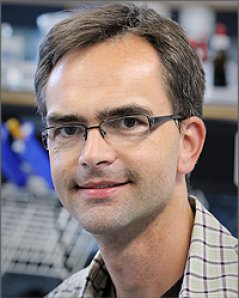News
Complex communities of micro-organisms are charted
Inauguration prof. Hauke Smidt.

‘Till death do us part’ – This is not only a wedding promise, it also describes our relationship with the incredible diversity of micro-organisms inside and around us, Remarkably only a small minority of the inhabitants of this micro world has been identified. Professor Hauke Smidt plans to further chart the composition and function of microbial communities and unlock their potential for applications. This is his message in his inaugural speech on 16 June when he accepts the office of personal professor of Complex Microbial Ecosystems at Wageningen University, part of Wageningen UR.
In order to chart the composition and function of the microbial communities. Professor Smidt uses biomolecular methods and genomics. “Micro-organisms can be found in our own bodies, on land, in the sea and in the air – everywhere, in fact”, according to the new professor. Man and animal carry ten times more microbial cells than their own body cells. These micro-organisms are mainly bacteria, but also archaea and fungi. They are generally found in the gastrointestinal tract, but they also abound in the oral cavity, on the skin and other places in the body. Professor Smidt describes the research into these microbiota as a ‘microbial voyage of discovery through the dark passages of the digestive system’.
In this internal environment, billions of micro-organisms are involved in breaking down food, producing important nutrients such as vitamins, short chain fatty acids, essential amino acids and stimulating the immune system. Although most of these mainly anaerobic micro-organisms have not yet been isolated and grown in pure culture, molecular biological research has considerably increased our knowledge of intestinal microbiota, particularly in the past fifteen years. We are now able to reveal and identify intestinal bacteria without growing them, for example by using microchips developed in Wageningen, which can show all the microbial intestinal inhabitants at once. Research not only focuses on the human intestine, but also those of farm animals like pigs, cows and chickens. The research also produces important new insights into the selection of feed additives to replace antibiotics in livestock farming, a crucial goal in the agro-food sector.
Marine micro-organisms
Micro-organisms not only occur in the intestines of vertebrates but also in marine invertebrates, including sponges and coral. There they make an important contribution to the production of in many cases halogenated bioactive substances. The pharmaceutical industry is one of the sectors which is showing great interest.
The search for the way in which micro-organisms produce these bioactive organic molecules is a second spearhead of Professor Smidt’s research. For this purpose, he uses a combination of innovative miniaturised culture techniques and metagenomic and metaproteomic approaches in order to predict the activity of all micro-organisms in a certain environment.
Microbial clean-up
Microbial consortia can also be efficiently used to clear up environmental contaminants, including halogenated (containing chlorine, for example)) hydrocarbons. The development and use of a wide range of assays for the molecular environmental diagnostics has resulted in new insights about which microbial networks are most efficient for organic sanitation and under which environmental conditions such decompositions in polluted land and groundwater proceed most quickly. In addition, the use of functional metagenomics has improved the understanding of the role of different bacteria in these decomposition processes.
Professor Smidt’s chair is part of the Laboratory for Microbiology at Wageningen University.